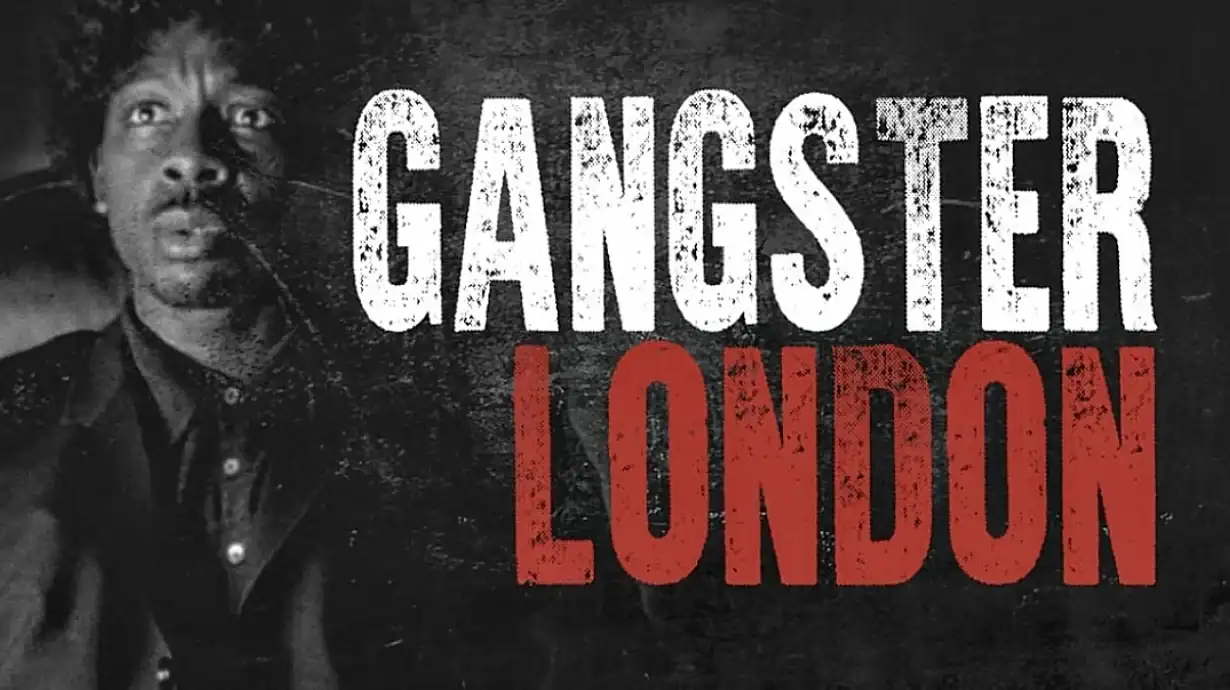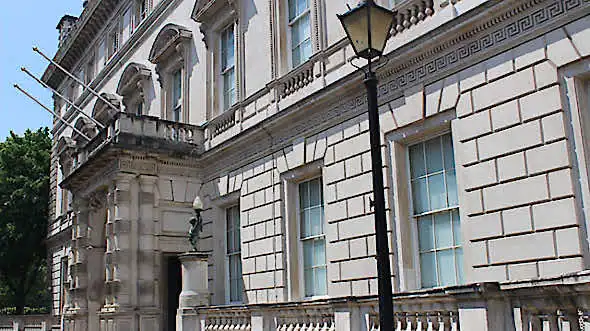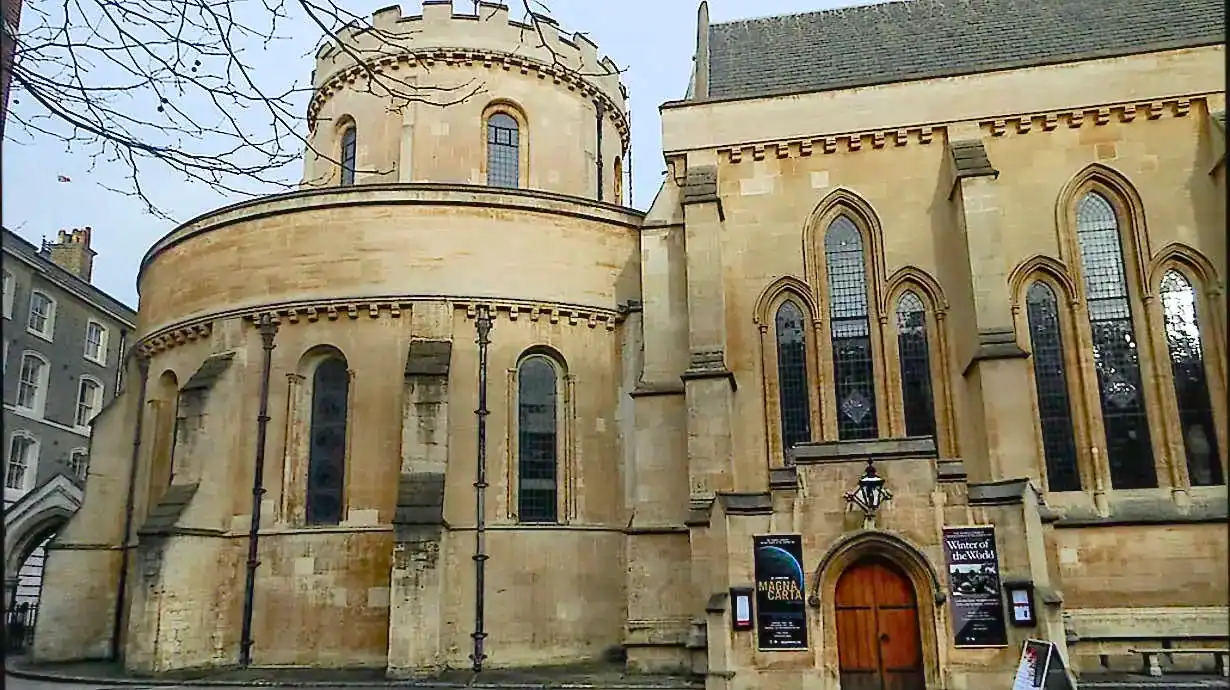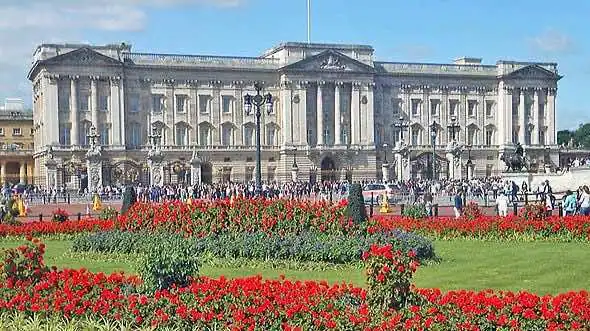
Westminster Abbey is practically a miracle – it’s the English equivalent of the Valley of the Kings. When you look at all of the Royal tombs inside you’ll be amazed at how many survived. Some of England’s greatest kings and queens are buried in here: people like Edward I, Henry V and Elizabeth I. Not forgetting our very own saint, of course – Edward the Confessor – whose tomb dates back to 1066. Unfortunately you have to pay a lot of money to get inside so it’s not much good for our walk, so let’s just head round the back to the Houses of Parliament instead.
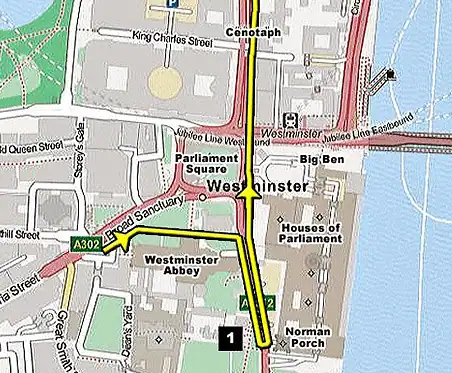
We’re going to start at the far end (the opposite end to Big Ben) and look at that gigantic porch and door [see 1 on the map]. That is called the Norman Porch, and it’s where the King rides her carriage in for the State Opening of Parliament. A line of fancy soldiers will help him down the steps and he’ll disappear inside to read the speech.
This entire area all the way up to Horse Guards used to be the site of Whitehall Palace and the Palace of Westminster, parts of which dated back to the reign of Henry VIII. It was where our kings and queens lived before they built Buckingham Palace. Unfortunately we’ve only got a few bits and pieces remaining now because Whitehall Palace burnt down to the ground in 1698 and the Palace of Westminster went up in smoke in 1834.
It’s very confusing having so many palaces in London (we haven’t even mentioned Kensington Palace and St. James’s yet!) and four of them are still around today – the Houses of Parliament are still technically regarded as a Royal palace. The biggest survivor from the original palace (the Palace of Westminster, I mean – are you following this? Come on, keep up!) is Westminster Hall, which dates all the way back to the 11th century. You can see it from our standing spot here: it’s that building attached to Parliament behind the statue of Richard the Lionheart. There’s a great picture of him during the Blitz, holding his bent sword up in the sky. The Luftwaffe dropped a few bombs on Parliament and managed to bust his sword with a bit of shrapnel. They briefly thought about leaving the bent sword as a defiant reminder but in the end they decided it just looked daft and banged it back into shape.
But anyway… Westminster Hall. That big window at the front is actually a later addition – but you can see the original walls round to the side. This is where they held the State trials of guys like William Wallace and Guy Fawkes. Charles I was tried and sentenced in there as well, shortly before getting his head chopped off outside Banqueting House (which we will see later). You can actually go inside Westminster Hall if you like (right now). You don’t need to pay a penny and you don’t need any ID. Just have a quick read of my House of Commons review and it will tell you how to do it – it’s definitely worth a look because you can see a plaque on the floor pointing out where Charles I was sitting when he got his death sentence.
Let’s have a stroll down Whitehall now. Four hundred years ago we’d be walking straight through the centre of the Whitehall Palace, and I’m going to point out the two bits that still survive above ground. (There are plenty more walls inside the surrounding government buildings, but only two bits are visible to the public.)
Before we get to those, though, let me just mention a few other landmarks along the way. That big concrete monument in the centre of the road is the Cenotaph. That’s where the Queen lays her wreath on Remembrance Day – it’s probably got a few wreaths around it even now. It seems to be permanently pimped in poppies the whole year round. This is also where you’ll find a few protesters camping out and banging on about crimes that no one cares about. At the time of writing it’s all about forced adoption in Eritrea. What has that got to do with the British Prime Minister? He probably couldn’t even point to Eritrea on a map. They may as well be shouting at the sky.
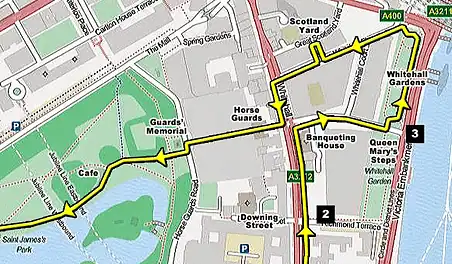
After the Cenotaph comes the big black iron gate of Downing Street [see 2 on the map]. It’s worth having a quick look just to see if you can spot the Prime Minister coming out, but I’ve never seen him once, and I’ve passed down here a million times. We need to find a way to flush him out… maybe send him a kissogram or a bunch of balloons.
Continue down Whitehall until you see a million billion tourists standing outside Horse Guards. Look for the two horse boxes out the front (if you have arrived too early or too late then the horses might still be in bed – there is a stables located inside the building on the right). This is one of the most popular photo spots in London, and those poor soldiers have to stand there for six hours whilst the tourists treat them like a waxwork exhibit at Madame Tussauds. It must drive them nuts. One day I’m fully expecting to see them go berserk and start slashing their swords about in a blind fury as one too many tourists start laughing at their hat. But they seem quite happy today, so I guess they must have learned to tune them out. (Maybe they’ve got radios inside their bearskins.)
Over the road from Horse Guards is Banqueting House (on the corner of Horse Guards Avenue). This is the single biggest survivor from Whitehall Palace, and if you’re thinking that the rest of Whitehall Palace was built on this scale, then you’re wrong. This seems to be the very best part of it, and it was the only room that they managed to save from the fire – chiefly because it’s got a huge Rubens on the ceiling. It also has the most history attached to it, because this is where they chopped off Charles I head.
Following his defeat and capture after the English Civil War, he was tried as a traitor in Westminster Hall and spent his final night in St. James’s Palace before coming here to psych himself up. Oliver Cromwell wanted the public to see the grisly deed so they built a big wooden stage in the street, which jutted up against the front of Banqueting House. Charles then stepped out of a specially constructed door that they knocked into the wall on the first floor. Then he said a few words and lost his head. You can still see his head in a bust above the door (obviously it’s not his real head!).
Now take a little detour down Horse Guards Avenue, and straight past the Ministry of Defence. On the corner of the lawn (on the right) you should be able to see some grey concrete steps leading down into nowhere [see 3 on the map]. I admit that they look very bland and boring these days, but these are actually another rare survival from Whitehall Palace. They are called Queen Mary’s Steps, and they were built by Christopher Wren in 1691 as a promenade along the riverfront. It gives you a good idea of how wide the river used to be before the Victorians built the Embankment, because the river is nowhere near the steps now. Unfortunately the palace burnt down just seven years later, so Queen Mary didn’t get much use out of them. But I don’t suppose she cared… because she’d already been dead for four years anyway!
Now cross over into Whitehall Gardens on the other side of the road. I think this is one of the nicest little gardens around, and the buildings at the back are beautiful. It’s just a shame about the traffic noise roaring down the Embankment. Have a little sit down and a rest and then continue through the garden and turn left into Whitehall Place.
Three-quarters of the way down the street is another turning on the right called Scotland Place. This is the original site of Scotland Yard. When we think of Scotland Yard these days we always think about the coppers, but back in the days before James I this was where the Scottish kings stayed when they came to see the English king at Whitehall Palace. And to keep the Scottish kings happy they actually designated it as Scottish soil – and apparently it still is! So in much the same way that foreign embassies are designated as foreign soil nowadays, this piece of concrete is still regarded as Scottish. It’s the only place in London where someone can play the bagpipes and not get beaten up (that’s not true). Personally I think this whole ‘Scottish soil’ story is a load of old nonsense, but that’s the popular legend.
Now continue along Whitehall Place and back out into Whitehall again, where you can cross over the road to Horse Guards (remember to look towards the right for a view of Nelson’s Column).
Walk between the two horse boxes and into the small courtyard beyond, and hopefully you will see two more Foot Guards standing off to the side. It wasn’t so long ago that you could actually stand right next to them and have your photo taken, but in these terrorist times they are protected by metal chains and machine-gun coppers.
If you walk through the central arch then you will come out into Horse Guards Parade. (You might also like to read my reviews of the Changing the Guard ceremony and Dismounting ceremony, because if you time your visit right then you can watch some pomp and pageantry.)
The Horse Guards building that we see today was built fifty years after the big fire, but it stands on the same site as the original Tiltyard. That’s where Henry VIII used to do all of his jousting contests before he got too fat to sit on his horse.
Have a stroll through the parade ground and head into St. James’s Park via the lefthand side of the Guards’ Memorial. You will see a big lake straight ahead and we need to keep to the northern edge (…on the right). If you like ducks then you’re in luck, because there are more ducks living here than anywhere else on Earth. Personally I can’t stand them. I hate ducks. I had a bad experience with one once that I’d rather not get into… suffice to say that three of my dogs dropped dead and my underpants caught fire. So you’ll forgive me if we move swiftly on.
The park that we see today was largely modelled by Charles II, who linked all of the little ponds into one big lake. Before that is was just a lot of marshy bogs. Charles also introduced all of the birds and had a few flamingos and crocodiles on show. I’m pretty sure that the crocodiles are gone now… but be careful where you’re stepping.
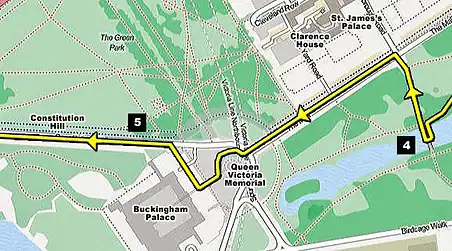
Halfway up the lake is a little bridge. Have a walk across there and get your first good look at Buckingham Palace in the distance [see 4 on the map]. This is easily one of the most popular photo spots in London, but I wish they would chop that damn tree down (you will know what I mean when you see it). If you spin around 180 degrees then you can get a great shot of Horse Guards Parade too. This view is even better when they turn the fountain on, so I wish you luck with that (because they don’t always do it).
Now return over the bridge again (exactly the same way that you came) and continue walking in that direction until you intersect with the Mall. Cross over the road and turn left towards Buckingham Palace.
Before we get to Buckingham Palace there are a couple of other buildings with a Royal connection. First up is St. James’s Palace, which is that brown brick building behind the wall. The thing that I love most about this palace is that it was built on the site of an old leper hospital – I’m being serious! This was back in the days when St. James’s Park was still a boggy marshland. But Henry VIII decided that he wasn’t very fond of lepers and knocked down the hospital so he could drain the land and use it for a palace. Sadly the only bit that still survives from his day is the gatehouse into Colour Court.
The palace’s hey-day came in the early 1700s after Whitehall Palace burnt down. But then George III bought Buckingham House and turned it into a posh house for his Queen, who passed it onto her son – George IV. He was the guy who started work on turning Buckingham House into a proper palace, which wasn’t completed until the reign of Queen Victoria.
Nowadays of course, the Queen always lives at Buckingham Palace and St. James’s has become largely forgotten in the eyes of the public; but behind the scenes it still plays a primary role in the Queen’s affairs. It’s probably the one building on London that I’d love to see inside, but it’s firmly out of bounds. We can’t go in there, and we probably never will.
That white creamy building on the end of St. James’s Palace is Clarence House. (You can only see the top half of it above the wall.) Everyone remembers this place as being the home of our beloved Queen Mother, who died at the ripe old age of 195 in 2002. She used to live in Buckingham Palace until her husband George VI dropped dead in 1952, and then she had to move into this pokey little place to make way for her daughter (that must have led to a few family arguments!).
Okay… here we are at last. We’ve come to the big one – Buckingham Palace. Check out the flagpole at the top first of all… if the Royal Standard is flying then that means the Queen is at home and you can pop in for a cup of tea. If it’s the Union Jack then that means she’s somewhere else.
I’ve never really been a fan of Buckingham Palace as a building. It looks fantastic on the inside, but it’s a bit too plain for my tastes. If they offered me the crown then I think I would have to refuse. I’d tell them that if they really wanted me as king then they’d have to build me a brand new palace first.
We’re going to start our long walk towards Kensington Palace now, so head up the righthand side of the palace along Constitution Hill [see 5 on the map]. Apparently Charles II used to walk up here and swear it was good for his constitution – hence the name. Be careful that you don’t get shot though, because this road is notorious for assassination attempts. Queen Victoria got shot at on three separate occasions during the 1840s, whilst sitting in her carriage. How can you miss her when she’s sitting in a slow moving carriage? She’s almost like a sitting duck. Incompetent fools. I would definitely have got her.
On the other side of that wall is Buckingham Palace Gardens; but do you remember that old leper hospital I was talking about underneath the grounds of St. James’s Palace? Well, the hospital graveyard was over to our righthand side in Green Park. So on one side of the road we’ve got the Queen’s ornamental gardens, and on the other side we’ve got a load of dead lepers.
If you want a cheap way of peeking into the Queen’s gardens without forking out for a tour, then you can pay a few quid and climb to the top of Wellington Arch. There’s a balcony at the summit which lets you see a very thin sliver of the gardens over the wall (but nothing very interesting). The chance of you seeing the Queen is close to zero (she probably avoids that area for security reasons), but you might be able to spy one of her gardeners having a cheeky fag break.
It’s certainly a very fine arch, and you might think that it has got nothing to do with the Royals… but it was actually commissioned by George IV in 1825 as part of the route down to Buckingham Palace. Back then it was called Constitution Arch after the road, and had a statue of the Duke of Wellington on top, who used to live in the sandstone-coloured Apsley House by Hyde Park. These days we all know it as Wellington Arch.
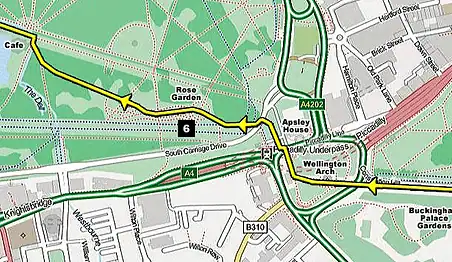
Cross over the busy road and head through the centre of those stone archways into the park. Then stroll over the zebra crossing and check out the map. We want to take the path through the Rose Garden towards the lake [see 6 on the map].
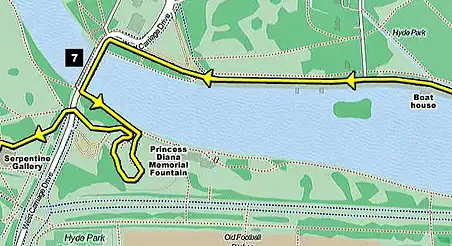
Follow the path around the top of the cafe and then walk along the northern edge of the lake (avoiding the ducks). When you reach the central bridge cross over and take a few photos [see 7 on the map]. You can actually see the top of Parliament and Westminster Abbey from here – look at how far we’ve walked! I’m surprised that were still alive – we’ve walked miles. You should also be able to see the tip of the Princess Diana Memorial Fountain on the opposite bank.
Now compare the bland Princess Diana Memorial with the one that’s coming up next – the Albert Memorial. What a contrast! That’s the difference between someone who was loved by a Queen, and one who wasn’t.
Albert’s marker is so outrageously over the top that you’d think he was a saint. It is bounded by a ring of worthies and scantily clad beauties and there he is in the middle: ten feet tall and all moulded in gold. I look at it not so much as a memorial to a prince, but as a memorial to the world’s most beloved husband.
We’re into the final stretch now so hang on – I know we’ve been walking for a long time but we’re nearly there. What do you think of Kensington Palace? It’s a bit disappointing isn’t it? It doesn’t look big enough for a king. The most historically important monarchs to live here were William III and Queen Victoria who grew up here as a child. Princess Diana lived here after she got dumped for Camilla. These days it’s home to Prince William and Kate.

You can’t get inside the palace without paying but you can have a look around some of the grounds. So start by walking around the lefthand side to see the golden gates and the statue of William III [see 8 on the map], and then walk across the face of the palace (past the cafe) and see the sunken garden (up the steps). That red brick building straight ahead is the Orangery, where you can treat yourself to some lunch. Then you can go home and have a sleep because you must be knackered.
 Twitter
Twitter Facebook
Facebook Bluesky
Bluesky WhatsApp
WhatsApp Email
Email




